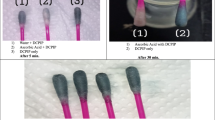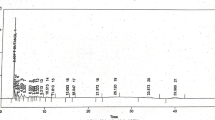Abstract
Phyllanthus niruri contains various lignan compounds, whose concentrations vary depending on several factors. This study was intended to determine the phyllanthin content of P. niruri obtained from various locations in Indonesia by using thin-layer chromatography (TLC)‒densitometry to evaluate the effect of geographical factors on their quality. The TLC system comprised silica gel 60 F254 for the stationary phase, toluene‒ethyl acetate‒formic acid (15:10.5:1.5, V/V) for the mobile phase, and documentation under ultraviolet (UV) 254 nm light without chemical reagents. This developed method meets the specificity requirement, as marked by the identical UV spectrum between the phyllanthin sample and the standard (λmax = 279 and 230 nm). Further, it shows good linearity for phyllanthin concentrations in the range of 2.36‒11.8 µg/band (r = 0.9924), with LOD 0.532 µg/band and LOQ 1.612 µg/band. It also has good intraday and interday precision, as indicated by RSD of 8.87–9.43 and 6.94%, respectively. Eight of the 15 analyzed samples (collected from Batu, Blitar, Kediri, Nganjuk, Jember, Mojokerto, Banyuwangi, and Surabaya) contained only a trace amount of phyllanthin. In contrast, the other seven had varying levels of phyllanthin (1.376‒4.130 mg/g dried herbs). Using the Tawangmangu sample as the reference, these seven samples can be grouped into two: significantly lower phyllanthin contents (Tulungagung) and very significantly lower phyllanthin contents (Lumajang, Bangkalan, Pasuruan, Sidoarjo, and Gresik). It can be concluded that TLC‒densitometry designed in this research is a straightforward method that, at the same time, meets the validation parameters. Therefore, it can be repeated to analyze phyllanthin in P. niruri of different phytogeographical origins.









Similar content being viewed by others
Data availability
All data generated or analyzed during this study are included in this published article. Any further data can be requested from the corresponding author.
References
Bagalkotkar G, Sagineedu S, Saad M, Stanslas J (2006) Phytochemicals from Phyllanthus niruri Linn. and their pharmacological properties: a review. J Pharm Pharmacol 58(12):1559–1570. https://doi.org/10.1211/jpp.58.12.0001
Lee N, Khoo W, Adnan M, Mahalingam T, Fernandez A, Jeevaratnam K (2016) The pharmacological potential of Phyllanthus niruri. J Pharm Pharmacol 68(8):953–969. https://doi.org/10.1111/jphp.12565
Okoli CO, Obidike I, Ezike A, Akah P, Salawu O (2011) Studies on the possible mechanisms of antidiabetic activity of extract of aerial parts of Phyllanthus niruri. Pharm Biol 49(3):248–255. https://doi.org/10.3109/13880209.2010.501456
Paithankar V, Raut K, Charde R, Vyas J (2015) Phyllanthus niruri: a magic herb. Res Pharm 1(4). https://updatepublishing.com/journal/index.php/rip/article/view/215
Sharma V, Kaushik S, Pandit P, Dhull D, Yadav JP, Kaushik S (2019) Green synthesis of silver nanoparticles from medicinal plants and evaluation of their antiviral potential against chikungunya virus. Appl Microbiol Biotechnol 103:881–891. https://doi.org/10.1007/s00253-018-9488-1
Tjandrawinata R, Susanto L, Nofiarny D (2017) The use of Phyllanthus niruri L. as an immunomodulator for the treatment of infectious diseases in clinical settings. Asian Pac J Trop Dis 7(3):132–140. https://doi.org/10.12980/apjtd.7.2017D6-287
Mukherjee PK (2019) Quality control and evaluation of herbal drugs: evaluating natural products and traditional medicine. Elsevier, Amsterdam, pp 53–74
Kartini K, Wulandari WA, Jayani NIE, Setiawan F (2021) TLC-based fingerprinting for Phyllanthus niruri from diverse geographical origins in East and Central Java Indonesia. IOP Conf Ser Earth Environ Sci 948:012003
Kartini K, Hardianti D, Hadiyat M (2021) Identification of Phyllanthus niruri by FTIR spectroscopy with chemometrics. Pharmaciana 11(2):251–260. https://doi.org/10.12928/pharmaciana.v11i2.15954
Shen M-R, He Y, Shi S-M (2020) Development of chromatographic technologies for the quality control of Traditional Chinese Medicines in the Chinese Pharmacopoeia. J Pharm Anal 11(2):155–162. https://doi.org/10.1016/j.jpha.2020.11.008
Sherma J (2000) Thin-layer chromatography in food and agricultural analysis. J Chromatogr A 880(1–2):129–147. https://doi.org/10.1016/S0021-9673(99)01132-2
Health IMo, (2017) Farmakope Herbal Indonesia Edisi II. Departemen Kesehatan Republik Indonesia, Jakarta
Liu C, Guo D-A, Liu L (2018) Quality transitivity and traceability system of herbal medicine products based on quality markers. Phytomedicine 44:247–257. https://doi.org/10.1016/j.phymed.2018.03.006
Li S, Han Q, Qiao C, Song J, Cheng CL, Xu H (2008) Chemical markers for the quality control of herbal medicines: an overview. Chin Med 3(1):7. https://doi.org/10.1186/1749-8546-3-7
Nasrulloh R, Rafi M, Wahyuni W, Shimma S, Heryanto R (2018) HPLC fingerprint and simultaneous quantitative analysis of phyllanthin and hypophyllanthin for identification and authentication of Phyllanthus niruri from related species. Rev Bras Farmacogn 28:527–532. https://doi.org/10.1016/j.bjp.2018.04.014
Kartini K, Putri RE, Budiono R (2023) Quantification of sinensetin in Orthosiphon stamineus from various phytogeographical zones in Indonesia. J Appl Pharm Sci 13(03):183–191. https://doi.org/10.7324/JAPS.2023.80035
Gandhi SP, Chitlange SS, Bandgar MH, Gawhane AR (2018) HPTLC analysis and stability study of phyllanthin biomarker in tablet formulation. Int Res J Pharm 9(9):140–144. https://doi.org/10.7897/2230-8407.099202
Tatiya A, Patil R, Sutar M, Shirkhedkar A, Surana S (2011) Determination of phyllanthin and gallic acid in herbal hepatoprotective formulation by TLC-densitometry analysis. Pharmacogn J 3(26):39–43
Nurhayati R, Primaharinastiti R, Yuwono M (2020) Optimasi Metode dan Uji Stabilitas pada Penetapan Kadar Filantin dalam Ekstrak Phyllanthus niruri Menggunakan KLT-Densitometri. J Farm Dan Ilmu Kefarmasian Indonesia 7(2):74
Rafi M, Heryanto R, Septiningsih DA (2017) Atlas kromatografi lapis tipis tumbuhan obat Indonesia. IPB Press, Bogor
Spangenberg B, Poole CF, Weins C (2011) Quantitative thin-layer chromatography: a practical survey. Springer, Berlin
Renger B, Végh Z, Ferenczi-Fodor K (2011) Validation of thin layer and high performance thin layer chromatographic methods. J Chromatogr A 1218(19):2712–3221. https://doi.org/10.1016/j.chroma.2011.01.059
Patel LJ, Raval MA, Patel SG, Patel AJ (2019) Development and validation of stability indicating high-performance thin-layer chromatographic (HPTLC) method for quantification of asiaticoside from Centella asiatica L. and its marketed formulation. J AOAC Int 102(4):1014–1020. https://doi.org/10.5740/jaoacint.18-0381
Khatoon S, Irshad S (2021) A validated high-performance thin-layer chromatography method for the determination of two bioactive lignans, phyllanthin and hypophyllanthin, in the seasonal variation study of Phyllanthus amarus. J Planar Chromatogr 34:427–435. https://doi.org/10.1007/s00764-021-00129-1
Khabiya R, Upadhyay D, Srivastava A, Anandjiwala S (2014) Simultaneous quantification of three bioactive lignans, viz., phyllanthin, hypophyllanthin, and niranthin from Phyllanthus amarus using high-performance thin-layer chromatography. J Planar Chromatogr Mod TLC 27(4):281–286
Hamrapurkar P, Pawar S, Phale M (2010) Quantitative HPTLC analysis of phyllanthin in Phyllanthus amarus. J Planar Chromatogr 23(2):112–115. https://doi.org/10.1556/jpc.23.2010.2.4
De Souza JAL, da Silva WAV, Bezerra ICF, Ferreira MRA, Soares LAL (2018) Chemical profiles by thin-layer chromatography and high-performance liquid chromatography of plant species from Northeast Brazil. Pharmacogn Mag 14(56):437–443. https://doi.org/10.4103/pm.pm_225_17
Yarni L, Murhandini S, Usia T (2015) Fingerprint study of Phyllanthus niruri L. by high performance thin layer chromatography (HPTLC). In: International seminar on promoting local resources for food and health, Bengkulu, 2015
Wahyuni WT, Saharah M, Arif Z, Rafi M (2020) Thin layer chromatographic fingerprint and chemometrics analysis for identification of Phyllanthus niruri from its related species. J Indian Chem Soc 3(1):47–52. https://doi.org/10.34311/jics.2020.03.1.47
Ketmongkhonsit P, Chaichantipyuth C, Palanuvej C, Thitikornpong W, Sukrong S (2015) A validated TLC-image analysis method for detecting and quantifying bioactive phyllanthin in Phyllanthus amarus and commercial herbal drugs. Songklanakarin J Sci Technol 37(3):319–326
Tripathi AK, Verma RK, Gupta AK, Gupta MM, Khanuja SP (2006) Quantitative determination of phyllanthin and hypophyllanthin in Phyllanthus species by high-performance thin layer chromatography. Phytochem Anal 17(6):394–397. https://doi.org/10.1002/pca.936
Khan S, Al-Qurainy F, Ram M, Ahmad S, Abdin MZ (2010) Phyllanthin biosynthesis in Phyllanthus amarus Schum and Thonn growing at different altitudes. J Med Plants Res 4(1):41–48. https://doi.org/10.5897/JMPR09.369
Srivastava M (2010) High-performance thin-layer chromatography (HPTLC). Springer, Berlin
Zlatkis A, Kaiser RE (eds) (2011) HPTLC—high performance thin-layer chromatography. Elsevier, Amsterdam
Funding
This research was funded by the Indonesian Ministry of Education, Culture, Research and Technology, Grant Number 011/SP-Lit/LPPM-01/KemendikbudRistek/FF/V/2023.
Author information
Authors and Affiliations
Corresponding author
Ethics declarations
Conflict of interest
The authors declare no conflict of interest. The funders had no role in the design of the study; in the collection, analyses, or interpretation of data; in the writing of the manuscript; or in the decision to publish the results.
Rights and permissions
Springer Nature or its licensor (e.g. a society or other partner) holds exclusive rights to this article under a publishing agreement with the author(s) or other rightsholder(s); author self-archiving of the accepted manuscript version of this article is solely governed by the terms of such publishing agreement and applicable law.
About this article
Cite this article
Kartini, K., Wijayati, A.S., Jayani, N.I.E. et al. Straightforward thin-layer chromatography–densitometric method for the determination of phyllanthin in Phyllanthus niruri from different phytogeographical zones. JPC-J Planar Chromat 37, 1–10 (2024). https://doi.org/10.1007/s00764-023-00257-w
Received:
Accepted:
Published:
Issue Date:
DOI: https://doi.org/10.1007/s00764-023-00257-w




